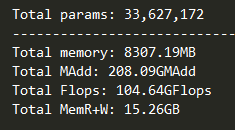- pytorch v1.4.0安装问题
大柠丶
pytorch人工智能python
直接使用conda安装报错:(CenterNet)C:\Users\16323>condainstallpytorch==1.4.0torchvision==0.5.0cudatoolkit=10.1-cpytorch-cconda-forgeChannels:-pytorch-conda-forge-defaultsPlatform:win-64Collectingpackagemetadata
- Vision mamba(mamba_ssm)安装踩坑指南
ggitjcg
深度学习python
在这篇博客中,我将分享我在linux环境安装和使用VisionMamba(mamba_ssm)过程中遇到的一些问题和解决方法。前置检查:PyTorch和Python版本在安装mamba_ssm前,请确保你的PyTorch和Python环境版本正确。以下代码可用来检查环境信息:importtorchprint("PyTorchVersion:{}".format(torch.__version__)
- 关于forward函数
oioz
深度学习
定义forward函数是模型的核心前向传播逻辑,定义了输入数据如何在模型中传递和计算。它将输入数据通过模型的各层(如卷积层、全连接层等),计算出模型的输出。作用负责模型的主要计算逻辑。在训练和验证过程中都会被调用。特点必须实现:在PyTorch中,forward函数是模型的核心部分,必须显式定义。灵活性高:可以根据模型需要,自由定义forward函数的内容,包括各种计算操作。示例(PyTorch)
- 使用PyTorch搭建Transformer神经网络:入门篇
DASA13
pytorchtransformer神经网络
1.简介Transformer是一种强大的神经网络架构,在自然语言处理等多个领域取得了巨大成功。本教程将指导您使用PyTorch框架从头开始构建一个Transformer模型。我们将逐步解释每个组件,并提供详细的代码实现。2.环境设置首先,确保您的系统中已安装Python(推荐3.7+版本)。然后,安装PyTorch和其他必要的库:pipinstalltorchnumpymatplotlib3.P
- PyTorch数据归一化处理:transforms
2401_87555420
pytorch人工智能python
##1.数据归一化处理:transforms.Normalize###1.1理解torchvision*torchvision.transforms:常用的图像预处理方法*torchvision.datasets:常用的数据集Dataset实现*torchvision.models:常用的CV(预训练)模型实现torchvision.transforms:常用的数据预处理方法,提升泛化能力,包括:
- Pytorch中的torch.utils.data.Dataset 类
小白的高手之路
深度学习(DL)Pytorch实战深度学习pythonpytorch
1、使用方法fromtorch.utils.dataimportDataset2、torch.utils.data.Dataset类的定义classDataset(Generic[_T_co]):r"""Anabstractclassrepresentinga:class:`Dataset`.Alldatasetsthatrepresentamapfromkeystodatasamplesshou
- 从零搭建Pytorch模型教程(七)单机多卡和多机多卡训练
AI大模型探索者
pytorch人工智能pythontransformer深度学习ai机器学习
前言本文主要介绍单机多卡训练和多机多卡训练的实现方法和一些注意事项。其中单机多卡训练介绍两种实现方式,一种是DP方式,一种是DDP方式。多机多卡训练主要介绍两种实现方式,一种是通过horovod库,一种是DDP方式。单机单卡训练前面我们已经介绍了一个完整的训练流程,但这里由于要介绍单机多卡和多机多卡训练的代码,为了能更好地理解它们之间的区别,这里先放一个单机单卡也就是一般情况下的代码流程。impo
- PyTorch基础知识讲解(一)完整训练流程示例
苏雨流丰
机器学习pytorch人工智能python机器学习深度学习
文章目录Tutorial1.数据处理2.网络模型定义3.损失函数、模型优化、模型训练、模型评价4.模型保存、模型加载、模型推理Tutorial大多数机器学习工作流程涉及处理数据、创建模型、优化模型参数和保存训练好的模型。本教程向你介绍一个用PyTorch实现的完整的ML工作流程,并提供链接来了解这些概念中的每一个。我们将使用FashionMNIST数据集来训练一个神经网络,预测输入图像是否属于以下
- 用 pytorch 从零开始创建大语言模型(零):汇总
墨绿色的摆渡人
用pytorch从零开始创建大语言模型pytorch语言模型人工智能
用pytorch从零开始创建大语言模型(零):汇总本系列官方代码库:https://github.com/rasbt/LLMs-from-scratch/tree/main官方书籍:BuildaLargeLanguageModel(FromScratch)本系列文章:用pytorch从零开始创建大语言模型(一):理解大型语言模型用pytorch从零开始创建大语言模型(二):待更新用pytorch从
- TensorFlow和Pytorch在功能上的区别以及优势
Honeysea_70
#算法tensorflowpytorch人工智能
功能上的区别1.计算图TensorFlow:使用静态计算图(StaticGraph)。在运行模型之前,需要先构建完整的计算图,然后通过会话(Session)运行图。优点是性能优化更高效,适合大规模分布式训练和生产环境部署。缺点是调试相对复杂,因为计算图的构建和运行是分离的。PyTorch:使用动态计算图(DynamicGraph)。计算图是动态构建和执行的,每次迭代都会重新构建图。优点是调试方便,
- 【北上广深杭大厂AI算法面试题】计算机视觉篇...如何解决多尺度问题?
努力毕业的小土博^_^
AI算法题库人工智能算法计算机视觉深度学习神经网络
【北上广深杭大厂AI算法面试题】计算机视觉篇…如何解决多尺度问题?【北上广深杭大厂AI算法面试题】计算机视觉篇…如何解决多尺度问题?文章目录【北上广深杭大厂AI算法面试题】计算机视觉篇...如何解决多尺度问题?前言数据级别的多尺度模型架构上的多尺度表示FPN代码示例(PyTorch)说明其他多尺度处理方法总结欢迎铁子们点赞、关注、收藏!祝大家逢考必过!逢投必中!上岸上岸上岸!upupup大多数高校
- 【大模型书籍PDF】从零开始大模型开发与微调:基于PyTorch与ChatGLM (推荐)_从零开始大模型开发与微调 pdf
喝不喝奶茶丫
pytorch人工智能语言模型大模型转行大模型AI大模型微调
今天又来给大家推荐一本大模型方面的书籍。本书使用PyTorch2.0作为学习大模型的基本框架,以ChatGLM为例详细讲解大模型的基本理论、算法、程序实现、应用实战以及微调技术,为读者揭示大模型开发技术。本书配套示例源代码、PPT课件。(书籍分享)
- 树莓派4B arm平台aarch64 pip安装pytorch
纬领网络
pytorcharm深度学习
比如你要安装torch1.7.1的版本,你执行下面这行命令pip3installtorch==1.7.1torchvision==0.8.2torchaudio==0.7.2-fhttps://torch.kmtea.eu/whl/stable-cn.html
- 深度学习与目标检测系列(六) 本文约(4.5万字) | 全面解读复现ResNet | Pytorch |
小酒馆燃着灯
深度学习目标检测pytorch人工智能ResNet残差连接残差网络
文章目录解读Abstract—摘要翻译精读主要内容Introduction—介绍翻译精读背景RelatedWork—相关工作ResidualRepresentations—残差表达翻译精读主要内容ShortcutConnections—短路连接翻译精读主要内容DeepResidualLearning—深度残差学习ResidualLearning—残差学习翻译精读ResNet目的以前方法本文改进本质
- 深度学习与目标检测系列(三) 本文约(4万字) | 全面解读复现AlexNet | Pytorch |
小酒馆燃着灯
深度学习目标检测pytorchAlexNet人工智能
文章目录解读Abstract-摘要翻译精读主要内容1.Introduction—前言翻译精读主要内容:本文主要贡献:2.TheDataset-数据集翻译精读主要内容:ImageNet简介:图像处理方法:3.TheArchitecture—网络结构3.1ReLUNonlinearity—非线性激活函数ReLU翻译精读传统方法及不足本文改进方法本文的改进结果3.2TrainingonMultipleG
- python arm64_PyTorch-aarch64
人类0663号
pythonarm64
PyTorch源码编译步骤:1、源码编译环境:操作系统:debian9.12交换空间:1GPython版本:3.5硬件:CPU:RK3399(aarch64)内存:4G2、下载依赖包:下载pytorch及其依赖包时,默认从github上下载,如果网络不好、容易断开时,可在gitee上找到对应包克隆链接,然后修改对应配置文件,进行下载。需要细致耐心。3、编译主要参数:设置最大作业数:exportMA
- Pytorch使用手册-DCGAN 指南(专题十四)
AI专题精讲
Pytorch入门到精通pytorch人工智能python
1.Introduction本教程将通过一个示例介绍DCGANs(深度卷积生成对抗网络)。我们将训练一个生成对抗网络(GAN),在给它展示大量真实名人照片后,它能够生成新的“名人”图片。这里的大部分代码来源于PyTorch官方示例中的DCGAN实现,而本文档将对该实现进行详细解释,并阐明这种模型的运行机制及其背后的原因。无需担心,你不需要事先了解GAN的知识,但初次接触的读者可能需要花一些时间来理
- 【猫狗分类】Pytorch VGG16 实现猫狗分类1-数据清洗+制作标签文件
努力的小巴掌
pytorch分类项目pytorch分类人工智能
Pytorch猫狗分类用Pytorch框架,实现分类问题,好像是学习了一些基础知识后的一个小项目阶段,通过这个分类问题,可以知道整个pytorch的工作流程是什么,会了一个分类,那就可以解决其他的分类问题,当然了,其实最重要的还是,了解她的核心是怎么工作的。那首先,我们的第一个项目,就做猫狗的分类。声明:整个数据和代码来自于b站,链接:使用pytorch框架手把手教你利用VGG16网络编写猫狗分类
- PyTorch深度学习框架60天进阶学习计划 - 第28天:多模态模型实践(二)
凡人的AI工具箱
深度学习pytorch学习AI编程人工智能python
PyTorch深度学习框架60天进阶学习计划-第28天:多模态模型实践(二)5.跨模态检索系统应用场景5.1图文匹配系统的实际应用应用领域具体场景优势电子商务商品图像搜索、视觉购物用户可以上传图片查找相似商品或使用文本描述查找商品智能媒体内容推荐、图片库搜索通过内容的语义理解提供更精准的推荐和搜索社交网络基于内容的帖子推荐理解用户兴趣,提供更相关的内容推荐教育技术多模态教学资源检索教师和学生可以更
- PyTorch深度学习框架60天进阶学习计划 - 第28天:多模态模型实践(一)
凡人的AI工具箱
深度学习pytorch学习AI编程人工智能python
PyTorch深度学习框架60天进阶学习计划-第28天:多模态模型实践(一)引言:跨越感知的边界欢迎来到我们的PyTorch学习旅程第28天!今天我们将步入AI世界中最激动人心的领域之一:多模态学习。想象一下,如果你的模型既能"看"又能"读",并且能够理解图像与文字之间的联系,这将为我们打开怎样的可能性?今天我们将专注于构建图文匹配系统,学习如何使用CLIP(ContrastiveLanguage
- 【深度学习】 PyTorch一文详解
Nerous_
深度学习深度学习pytorch人工智能机器学习python
“PyTorchisadeeplearningframeworkthatprioritizessimplicityandflexibility,makingitthego-tochoiceforbothresearchersanddevelopers.”—Anonymous1.PyTorch简介1.1PyTorch的背景与发展PyTorch是由Facebook人工智能研究院(FAIR)开发的一个开
- Open-Sora - 为所有人实现高效的视频制作大众化
小众AI
AI开源音视频人工智能AI编程
GitHub:https://github.com/hpcaitech/Open-Sora更多AI开源软件:发现分享好用的AI工具、AI开源软件、AI模型、AI变现-小众AI这是一款开源的SOTA(State-of-the-Art)视频生成模型,仅用20万美元(224张GPU)就能训练出商业级11B参数的视频生成大模型。它采用Python语言和PyTorch深度学习框架开发,具有生成速度快、资源消
- 【ai】mocap:conda 安装python3.8+ cuda+ pytorch+torchaudio、torchvision
等风来不如迎风去
AI入门与实战人工智能ubuntuconda
MotionCapubuntu18.04不知道为啥会依赖于ffmpeg、xorg渲染?安装pytorch就是会带上cudacudnn啥的pytorch【ai】tx2nx:安装torch、torchvisionforyolov5这里就发现pytorch和torchvision有依赖关系的,还涉及到rapidjson所以python的环境隔离很重要。核心库-cudatoolkit=11.3-pytor
- Pytorch使用手册—扩展 TorchScript 使用自定义 C++ 操作符(专题五十三)
AI专题精讲
Pytorch入门到精通pytorchc++人工智能
提示本教程自PyTorch2.4起已弃用。有关PyTorch自定义操作符的最新指南,请参阅PyTorch自定义操作符。PyTorch1.0版本引入了一种名为TorchScript的新编程模型。TorchScript是Python编程语言的一个子集,可以被TorchScript编译器解析、编译和优化。此外,编译后的TorchScript模型可以选择序列化为磁盘文件格式,随后你可以从纯C++(以及Py
- 部分标签数据集生成与过滤特定标签方法
阳光明媚大男孩
机器学习人工智能
完整代码总结这段代码的目的是通过构建一个部分标签学习(PartialLabelLearning,PLL)框架来生成一个包含部分标签的数据集,并且支持根据给定的标签列表对数据集进行筛选和过滤。代码包含了多个类和函数,主要分为以下几部分:数据预处理与加载:使用PyTorch和torchvision来加载CIFAR-10数据集,并对其进行标准化处理。部分标签数据集的生成:为每个样本生成多个候选标签,并模
- 模型部署实战:PyTorch生产化指南
小诸葛IT课堂
pytorch人工智能python
一、为什么要做模型部署?模型部署是将训练好的模型投入实际应用的关键步骤,涉及:模型格式转换(TorchScript/ONNX)性能优化(量化/剪枝)构建API服务移动端集成本章使用ResNet18实现图像分类,并演示完整部署流程。二、模型转换:TorchScript与ONNX1.准备预训练模型importtorchimporttorchvision#加载预训练模型model=torc
- 下一代模型技术演进与场景应用突破
智能计算研究中心
其他
内容概要当前模型技术正经历多维度的范式跃迁,可解释性模型与自动化机器学习(AutoML)成为突破传统黑箱困境的核心路径。在底层架构层面,边缘计算与量子计算的融合重构了算力分配模式,联邦学习技术则为跨域数据协作提供了安全可信的解决方案。主流框架如TensorFlow和PyTorch持续迭代优化能力,通过动态参数压缩与自适应超参数调优策略,显著提升模型部署效率。应用层创新呈现垂直化特征,医疗诊断模型通
- PyTorch模型训练实战指南:掌握动态图特性与工业级部署技巧
lmtealily
pytorch人工智能python
前言在深度学习领域,PyTorch凭借其动态计算图、高效的自动微分系统及高度Pythonic的设计哲学,已成为学术界与工业界的主流框架。其即时执行模式大幅简化了模型调试流程,而灵活的模块化设计则为复杂模型的构建提供了坚实基础。然而,从实验原型到工业级部署的全链路实践中,开发者仍需系统性掌握框架核心特性与工程化技巧。本文以实战为导向,深入剖析PyTorch动态图机制与自动微分原理,详解从数据预处理、
- PyTorch 深度学习实战(19):离线强化学习与 Conservative Q-Learning (CQL) 算法
进取星辰
PyTorch深度学习实战深度学习pytorch算法
在上一篇文章中,我们探讨了分布式强化学习与IMPALA算法,展示了如何通过并行化训练提升强化学习的效率。本文将聚焦离线强化学习(OfflineRL)这一新兴方向,并实现ConservativeQ-Learning(CQL)算法,利用Minari提供的静态数据集训练安全的强化学习策略。一、离线强化学习与CQL原理1.离线强化学习的特点无需环境交互:直接从预收集的静态数据集学习数据效率高:复用历史经验
- Hugging Face 模型格式全解析:从 PyTorch 到 GGUF
mingo_敏
DeepLearningpytorch人工智能python
HuggingFace模型格式全解析:从PyTorch到GGUFHuggingFace生态支持多种模型格式,以满足不同场景下的存储、部署和推理需求。以下是主流格式的技术解析与演进脉络:1.PyTorch原生格式(.pt/.pth)特性:直接保存PyTorch的state_dict(模型参数)或完整模型(含结构)。兼容性强,与PyTorch训练/推理流程深度集成。文件体积较大,加载速度较慢,存在安全
- Spring4.1新特性——Spring MVC增强
jinnianshilongnian
spring 4.1
目录
Spring4.1新特性——综述
Spring4.1新特性——Spring核心部分及其他
Spring4.1新特性——Spring缓存框架增强
Spring4.1新特性——异步调用和事件机制的异常处理
Spring4.1新特性——数据库集成测试脚本初始化
Spring4.1新特性——Spring MVC增强
Spring4.1新特性——页面自动化测试框架Spring MVC T
- mysql 性能查询优化
annan211
javasql优化mysql应用服务器
1 时间到底花在哪了?
mysql在执行查询的时候需要执行一系列的子任务,这些子任务包含了整个查询周期最重要的阶段,这其中包含了大量为了
检索数据列到存储引擎的调用以及调用后的数据处理,包括排序、分组等。在完成这些任务的时候,查询需要在不同的地方
花费时间,包括网络、cpu计算、生成统计信息和执行计划、锁等待等。尤其是向底层存储引擎检索数据的调用操作。这些调用需要在内存操
- windows系统配置
cherishLC
windows
删除Hiberfil.sys :使用命令powercfg -h off 关闭休眠功能即可:
http://jingyan.baidu.com/article/f3ad7d0fc0992e09c2345b51.html
类似的还有pagefile.sys
msconfig 配置启动项
shutdown 定时关机
ipconfig 查看网络配置
ipconfig /flushdns
- 人体的排毒时间
Array_06
工作
========================
|| 人体的排毒时间是什么时候?||
========================
转载于:
http://zhidao.baidu.com/link?url=ibaGlicVslAQhVdWWVevU4TMjhiKaNBWCpZ1NS6igCQ78EkNJZFsEjCjl3T5EdXU9SaPg04bh8MbY1bR
- ZooKeeper
cugfy
zookeeper
Zookeeper是一个高性能,分布式的,开源分布式应用协调服务。它提供了简单原始的功能,分布式应用可以基于它实现更高级的服务,比如同步, 配置管理,集群管理,名空间。它被设计为易于编程,使用文件系统目录树作为数据模型。服务端跑在java上,提供java和C的客户端API。 Zookeeper是Google的Chubby一个开源的实现,是高有效和可靠的协同工作系统,Zookeeper能够用来lea
- 网络爬虫的乱码处理
随意而生
爬虫网络
下边简单总结下关于网络爬虫的乱码处理。注意,这里不仅是中文乱码,还包括一些如日文、韩文 、俄文、藏文之类的乱码处理,因为他们的解决方式 是一致的,故在此统一说明。 网络爬虫,有两种选择,一是选择nutch、hetriex,二是自写爬虫,两者在处理乱码时,原理是一致的,但前者处理乱码时,要看懂源码后进行修改才可以,所以要废劲一些;而后者更自由方便,可以在编码处理
- Xcode常用快捷键
张亚雄
xcode
一、总结的常用命令:
隐藏xcode command+h
退出xcode command+q
关闭窗口 command+w
关闭所有窗口 command+option+w
关闭当前
- mongoDB索引操作
adminjun
mongodb索引
一、索引基础: MongoDB的索引几乎与传统的关系型数据库一模一样,这其中也包括一些基本的优化技巧。下面是创建索引的命令: > db.test.ensureIndex({"username":1}) 可以通过下面的名称查看索引是否已经成功建立: &nbs
- 成都软件园实习那些话
aijuans
成都 软件园 实习
无聊之中,翻了一下日志,发现上一篇经历是很久以前的事了,悔过~~
断断续续离开了学校快一年了,习惯了那里一天天的幼稚、成长的环境,到这里有点与世隔绝的感觉。不过还好,那是刚到这里时的想法,现在感觉在这挺好,不管怎么样,最要感谢的还是老师能给这么好的一次催化成长的机会,在这里确实看到了好多好多能想到或想不到的东西。
都说在外面和学校相比最明显的差距就是与人相处比较困难,因为在外面每个人都
- Linux下FTP服务器安装及配置
ayaoxinchao
linuxFTP服务器vsftp
检测是否安装了FTP
[root@localhost ~]# rpm -q vsftpd
如果未安装:package vsftpd is not installed 安装了则显示:vsftpd-2.0.5-28.el5累死的版本信息
安装FTP
运行yum install vsftpd命令,如[root@localhost ~]# yum install vsf
- 使用mongo-java-driver获取文档id和查找文档
BigBird2012
driver
注:本文所有代码都使用的mongo-java-driver实现。
在MongoDB中,一个集合(collection)在概念上就类似我们SQL数据库中的表(Table),这个集合包含了一系列文档(document)。一个DBObject对象表示我们想添加到集合(collection)中的一个文档(document),MongoDB会自动为我们创建的每个文档添加一个id,这个id在
- JSONObject以及json串
bijian1013
jsonJSONObject
一.JAR包简介
要使程序可以运行必须引入JSON-lib包,JSON-lib包同时依赖于以下的JAR包:
1.commons-lang-2.0.jar
2.commons-beanutils-1.7.0.jar
3.commons-collections-3.1.jar
&n
- [Zookeeper学习笔记之三]Zookeeper实例创建和会话建立的异步特性
bit1129
zookeeper
为了说明问题,看个简单的代码,
import org.apache.zookeeper.*;
import java.io.IOException;
import java.util.concurrent.CountDownLatch;
import java.util.concurrent.ThreadLocal
- 【Scala十二】Scala核心六:Trait
bit1129
scala
Traits are a fundamental unit of code reuse in Scala. A trait encapsulates method and field definitions, which can then be reused by mixing them into classes. Unlike class inheritance, in which each c
- weblogic version 10.3破解
ronin47
weblogic
版本:WebLogic Server 10.3
说明:%DOMAIN_HOME%:指WebLogic Server 域(Domain)目录
例如我的做测试的域的根目录 DOMAIN_HOME=D:/Weblogic/Middleware/user_projects/domains/base_domain
1.为了保证操作安全,备份%DOMAIN_HOME%/security/Defa
- 求第n个斐波那契数
BrokenDreams
今天看到群友发的一个问题:写一个小程序打印第n个斐波那契数。
自己试了下,搞了好久。。。基础要加强了。
&nbs
- 读《研磨设计模式》-代码笔记-访问者模式-Visitor
bylijinnan
java设计模式
声明: 本文只为方便我个人查阅和理解,详细的分析以及源代码请移步 原作者的博客http://chjavach.iteye.com/
import java.util.ArrayList;
import java.util.List;
interface IVisitor {
//第二次分派,Visitor调用Element
void visitConcret
- MatConvNet的excise 3改为网络配置文件形式
cherishLC
matlab
MatConvNet为vlFeat作者写的matlab下的卷积神经网络工具包,可以使用GPU。
主页:
http://www.vlfeat.org/matconvnet/
教程:
http://www.robots.ox.ac.uk/~vgg/practicals/cnn/index.html
注意:需要下载新版的MatConvNet替换掉教程中工具包中的matconvnet:
http
- ZK Timeout再讨论
chenchao051
zookeepertimeouthbase
http://crazyjvm.iteye.com/blog/1693757 文中提到相关超时问题,但是又出现了一个问题,我把min和max都设置成了180000,但是仍然出现了以下的异常信息:
Client session timed out, have not heard from server in 154339ms for sessionid 0x13a3f7732340003
- CASE WHEN 用法介绍
daizj
sqlgroup bycase when
CASE WHEN 用法介绍
1. CASE WHEN 表达式有两种形式
--简单Case函数
CASE sex
WHEN '1' THEN '男'
WHEN '2' THEN '女'
ELSE '其他' END
--Case搜索函数
CASE
WHEN sex = '1' THEN
- PHP技巧汇总:提高PHP性能的53个技巧
dcj3sjt126com
PHP
PHP技巧汇总:提高PHP性能的53个技巧 用单引号代替双引号来包含字符串,这样做会更快一些。因为PHP会在双引号包围的字符串中搜寻变量, 单引号则不会,注意:只有echo能这么做,它是一种可以把多个字符串当作参数的函数译注: PHP手册中说echo是语言结构,不是真正的函数,故把函数加上了双引号)。 1、如果能将类的方法定义成static,就尽量定义成static,它的速度会提升将近4倍
- Yii框架中CGridView的使用方法以及详细示例
dcj3sjt126com
yii
CGridView显示一个数据项的列表中的一个表。
表中的每一行代表一个数据项的数据,和一个列通常代表一个属性的物品(一些列可能对应于复杂的表达式的属性或静态文本)。 CGridView既支持排序和分页的数据项。排序和分页可以在AJAX模式或正常的页面请求。使用CGridView的一个好处是,当用户浏览器禁用JavaScript,排序和分页自动退化普通页面请求和仍然正常运行。
实例代码如下:
- Maven项目打包成可执行Jar文件
dyy_gusi
assembly
Maven项目打包成可执行Jar文件
在使用Maven完成项目以后,如果是需要打包成可执行的Jar文件,我们通过eclipse的导出很麻烦,还得指定入口文件的位置,还得说明依赖的jar包,既然都使用Maven了,很重要的一个目的就是让这些繁琐的操作简单。我们可以通过插件完成这项工作,使用assembly插件。具体使用方式如下:
1、在项目中加入插件的依赖:
<plugin>
- php常见错误
geeksun
PHP
1. kevent() reported that connect() failed (61: Connection refused) while connecting to upstream, client: 127.0.0.1, server: localhost, request: "GET / HTTP/1.1", upstream: "fastc
- 修改linux的用户名
hongtoushizi
linuxchange password
Change Linux Username
更改Linux用户名,需要修改4个系统的文件:
/etc/passwd
/etc/shadow
/etc/group
/etc/gshadow
古老/传统的方法是使用vi去直接修改,但是这有安全隐患(具体可自己搜一下),所以后来改成使用这些命令去代替:
vipw
vipw -s
vigr
vigr -s
具体的操作顺
- 第五章 常用Lua开发库1-redis、mysql、http客户端
jinnianshilongnian
nginxlua
对于开发来说需要有好的生态开发库来辅助我们快速开发,而Lua中也有大多数我们需要的第三方开发库如Redis、Memcached、Mysql、Http客户端、JSON、模板引擎等。
一些常见的Lua库可以在github上搜索,https://github.com/search?utf8=%E2%9C%93&q=lua+resty。
Redis客户端
lua-resty-r
- zkClient 监控机制实现
liyonghui160com
zkClient 监控机制实现
直接使用zk的api实现业务功能比较繁琐。因为要处理session loss,session expire等异常,在发生这些异常后进行重连。又因为ZK的watcher是一次性的,如果要基于wather实现发布/订阅模式,还要自己包装一下,将一次性订阅包装成持久订阅。另外如果要使用抽象级别更高的功能,比如分布式锁,leader选举
- 在Mysql 众多表中查找一个表名或者字段名的 SQL 语句
pda158
mysql
在Mysql 众多表中查找一个表名或者字段名的 SQL 语句:
方法一:SELECT table_name, column_name from information_schema.columns WHERE column_name LIKE 'Name';
方法二:SELECT column_name from information_schema.colum
- 程序员对英语的依赖
Smile.zeng
英语程序猿
1、程序员最基本的技能,至少要能写得出代码,当我们还在为建立类的时候思考用什么单词发牢骚的时候,英语与别人的差距就直接表现出来咯。
2、程序员最起码能认识开发工具里的英语单词,不然怎么知道使用这些开发工具。
3、进阶一点,就是能读懂别人的代码,有利于我们学习人家的思路和技术。
4、写的程序至少能有一定的可读性,至少要人别人能懂吧...
以上一些问题,充分说明了英语对程序猿的重要性。骚年
- Oracle学习笔记(8) 使用PLSQL编写触发器
vipbooks
oraclesql编程活动Access
时间过得真快啊,转眼就到了Oracle学习笔记的最后个章节了,通过前面七章的学习大家应该对Oracle编程有了一定了了解了吧,这东东如果一段时间不用很快就会忘记了,所以我会把自己学习过的东西做好详细的笔记,用到的时候可以随时查找,马上上手!希望这些笔记能对大家有些帮助!
这是第八章的学习笔记,学习完第七章的子程序和包之后
